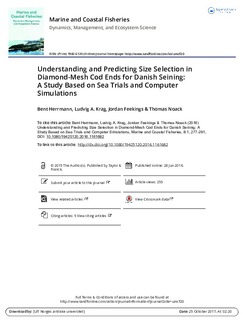Understanding and predicting size selection in diamond-mesh cod ends for Danish seining: a study based on sea trials and computer simulations
Journal article, Peer reviewed
Published version
Permanent lenke
http://hdl.handle.net/11250/2462220Utgivelsesdato
2016Metadata
Vis full innførselSamlinger
- Publikasjoner fra CRIStin - SINTEF Ocean [1403]
- SINTEF Ocean [1478]
Sammendrag
Danish seining is an important fishing method used to harvest demersal species. Knowledge about the size selectivity of different demersal species with this type of fishing gear is therefore of importance for managing the exploitation of marine resources. However, there are only limited data on size selection in cod ends in this fishery. Sea trials were therefore carried out to collect size selectivity data for Atlantic Cod Gadus morhua, Haddock Melanogrammus aeglefinus, and Witch Flounder Glyptocephalus cynoglossus for a diamond-mesh cod end. For all three species, the data were best described by a double logistic selection curve, implying that two different size selection processes occur in the cod end. The double selection process could be explained by an additional selection process occurring through slack meshes. The results imply that the escapement of 46% and 34% of the larger Atlantic Cod and Haddock (those above 48 cm), respectively, would be through wide-open or slack meshes. Since these mesh states are only likely to be present in the latest stage of the fishing process (e.g., when the cod end is near the surface), a large fraction of the bigger fish probably escaped near the surface, which might influence their likelihood of survival. Furthermore, based on the models established for explaining the experimental size selection, we were able to predict the effect of changing the mesh size on cod end size selection in the Danish seine fishery.

